Discover Florida Nature
It's time to explore the natural Florida


|
|
|
|
|
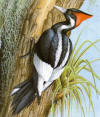 Ivory-Billed
Woodpecker- The Ivory-billed Woodpecker is one of several
species whose numbers have dwindled to the point where it is uncertain
whether any remain. The species is listed as critically endangered and
possibly extinct by the International Union for Conservation of Nature.
The Ivory-billed Woodpecker ranks among the largest woodpeckers in the
world and the largest in the United States. The bird is shiny blue-black
with white markings on its neck and back and extensive white on the
trailing edge of both the upper- and underwing. In adults, the bill is
ivory in color, chalky white in juveniles. Ivory-bills have a prominent
crest, although in juveniles it is ragged. The crest is black in
juveniles and females. In males, the crest is black along its forward
edge, changing abruptly to red on the side and rear. The chin of an
ivory-bill is black. When perched with the wings folded, ivory-bills of
both sexes present a large patch of white on the lower back, roughly
triangular in shape. These characteristics distinguish it from the
smaller and darker-billed Pileated Woodpecker. The Ivory Billed
Woodpecker was last seen in Florida in 1969! Ivory-Billed
Woodpecker- The Ivory-billed Woodpecker is one of several
species whose numbers have dwindled to the point where it is uncertain
whether any remain. The species is listed as critically endangered and
possibly extinct by the International Union for Conservation of Nature.
The Ivory-billed Woodpecker ranks among the largest woodpeckers in the
world and the largest in the United States. The bird is shiny blue-black
with white markings on its neck and back and extensive white on the
trailing edge of both the upper- and underwing. In adults, the bill is
ivory in color, chalky white in juveniles. Ivory-bills have a prominent
crest, although in juveniles it is ragged. The crest is black in
juveniles and females. In males, the crest is black along its forward
edge, changing abruptly to red on the side and rear. The chin of an
ivory-bill is black. When perched with the wings folded, ivory-bills of
both sexes present a large patch of white on the lower back, roughly
triangular in shape. These characteristics distinguish it from the
smaller and darker-billed Pileated Woodpecker. The Ivory Billed
Woodpecker was last seen in Florida in 1969! Red-Cockaded
Woodpecker- Once common in the vast expanses of mature pine
forests that covered much of the southeastern coastal plain, the
red-cockaded woodpecker is now a federally listed endangered species. A
red-cockaded woodpecker is slightly larger than a bluebird. It has a
large white cheek patch, and the top and back of the head are black. The
back is barred with black and white. The red-cockade, on the male only,
consists of a small red streak above the cheek and is rarely visible.
The red-cockaded woodpecker is unusual in two ways. First, it is the
only woodpecker that excavates cavities in the living part of pine
trees. Although they will use other pines such as loblolly, shortleaf or
slash, they usually prefer longleaf pines that are 90 - 100 years old.
Secondly, red-cockaded woodpeckers have an advanced social system. These
woodpeckers live in groups consisting of two to nine birds. Red-Cockaded
Woodpecker- Once common in the vast expanses of mature pine
forests that covered much of the southeastern coastal plain, the
red-cockaded woodpecker is now a federally listed endangered species. A
red-cockaded woodpecker is slightly larger than a bluebird. It has a
large white cheek patch, and the top and back of the head are black. The
back is barred with black and white. The red-cockade, on the male only,
consists of a small red streak above the cheek and is rarely visible.
The red-cockaded woodpecker is unusual in two ways. First, it is the
only woodpecker that excavates cavities in the living part of pine
trees. Although they will use other pines such as loblolly, shortleaf or
slash, they usually prefer longleaf pines that are 90 - 100 years old.
Secondly, red-cockaded woodpeckers have an advanced social system. These
woodpeckers live in groups consisting of two to nine birds.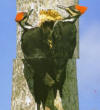 Pileated
Woodpecker- Nearly as large as a crow, the Pileated Woodpecker
is the largest woodpecker in most of North America. Its loud ringing
calls and huge, rectangular excavations in dead trees announce its
presence in forests across the continent. The Pileated Woodpecker digs
characteristically rectangular holes in trees to find ants. These
excavations can be so broad and deep that they can cause small trees to
break in half. The feeding excavations of a Pileated Woodpecker are so
extensive that they often attract other birds. Other woodpeckers, as
well as House Wrens, may come and feed there. A Pileated Woodpecker pair
stays together on its territory all year round. It will defend the
territory in all seasons, but will tolerate floaters during the winter. Pileated
Woodpecker- Nearly as large as a crow, the Pileated Woodpecker
is the largest woodpecker in most of North America. Its loud ringing
calls and huge, rectangular excavations in dead trees announce its
presence in forests across the continent. The Pileated Woodpecker digs
characteristically rectangular holes in trees to find ants. These
excavations can be so broad and deep that they can cause small trees to
break in half. The feeding excavations of a Pileated Woodpecker are so
extensive that they often attract other birds. Other woodpeckers, as
well as House Wrens, may come and feed there. A Pileated Woodpecker pair
stays together on its territory all year round. It will defend the
territory in all seasons, but will tolerate floaters during the winter.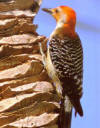 Red-Bellied
Woodpecker-
The Red-bellied Woodpeckers are pale, medium-sized woodpeckers common in
forests of the East. Their strikingly barred backs and gleaming red caps
make them an unforgettable sight – just resist the temptation to call it
a Red-headed Woodpecker, a somewhat rarer species that's mostly black on
the back with big white wing patches. Learn the Red-bellied's rolling
call and you’ll notice these birds everywhere. Look for Red-bellied
Woodpeckers hitching along branches and trunks of medium to large trees,
picking at the bark surface more often than drilling into it. Like most
woodpeckers, these birds have a characteristic undulating flight
pattern. Red-Bellied
Woodpecker-
The Red-bellied Woodpeckers are pale, medium-sized woodpeckers common in
forests of the East. Their strikingly barred backs and gleaming red caps
make them an unforgettable sight – just resist the temptation to call it
a Red-headed Woodpecker, a somewhat rarer species that's mostly black on
the back with big white wing patches. Learn the Red-bellied's rolling
call and you’ll notice these birds everywhere. Look for Red-bellied
Woodpeckers hitching along branches and trunks of medium to large trees,
picking at the bark surface more often than drilling into it. Like most
woodpeckers, these birds have a characteristic undulating flight
pattern.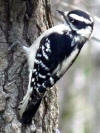 Downy
Woodpecker-
The Downy Woodpecker may be the most familiar woodpecker in North
America. It occurs throughout North America where woodlands are found,
being absent only from tundra regions of Canada and Alaska, and from
southern Texas. The downy woodpecker is virtually identical to the Hairy
Woodpecker, but is much smaller and with a much shorter bill. Only 15 to
17 cm long, the Downy Woodpecker is very small compared to most North
American woodpeckers. Its contrasting black and white plumage gives it a
formal tuxedo like appearance. The adult male sports a red patch on the
back of his head. The short, straight, chisel-like bill of the downy
woodpecker is especially suited for probing for insects and insect
larvae, and for chipping a cavity for a nest site. Downy
Woodpecker-
The Downy Woodpecker may be the most familiar woodpecker in North
America. It occurs throughout North America where woodlands are found,
being absent only from tundra regions of Canada and Alaska, and from
southern Texas. The downy woodpecker is virtually identical to the Hairy
Woodpecker, but is much smaller and with a much shorter bill. Only 15 to
17 cm long, the Downy Woodpecker is very small compared to most North
American woodpeckers. Its contrasting black and white plumage gives it a
formal tuxedo like appearance. The adult male sports a red patch on the
back of his head. The short, straight, chisel-like bill of the downy
woodpecker is especially suited for probing for insects and insect
larvae, and for chipping a cavity for a nest site. 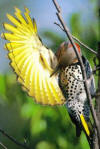 Common
Yellow Flicker- The Northern Flicker is a bird of open areas
and forest edges wherever open ground is available. This species is also
known as the Common Flicker and the Yellow-shafted Flicker. Unlike most
species of woodpeckers, Flickers forage mostly on the ground, consuming
ants, termites, caterpillars, crickets, grasshoppers, other insects,
spiders, berries, seeds, and nuts. The Flicker is about 13 inches long
with a wingspan of 18 to 21 inches. Weights range from 4 to 6 ounces.
Flickers have a gray crown with a prominent red chevron on the back of
the head. The yellow shafts of the feathers and its habit of flicking
its bill give the Yellow-shafted Flicker its name. The yellow shafts of
the primary flight feathers is noticeable in this photo. The spectacular
underside of the Yellow-shafted Flicker makes it easy to see how this
bird got its name. Common
Yellow Flicker- The Northern Flicker is a bird of open areas
and forest edges wherever open ground is available. This species is also
known as the Common Flicker and the Yellow-shafted Flicker. Unlike most
species of woodpeckers, Flickers forage mostly on the ground, consuming
ants, termites, caterpillars, crickets, grasshoppers, other insects,
spiders, berries, seeds, and nuts. The Flicker is about 13 inches long
with a wingspan of 18 to 21 inches. Weights range from 4 to 6 ounces.
Flickers have a gray crown with a prominent red chevron on the back of
the head. The yellow shafts of the feathers and its habit of flicking
its bill give the Yellow-shafted Flicker its name. The yellow shafts of
the primary flight feathers is noticeable in this photo. The spectacular
underside of the Yellow-shafted Flicker makes it easy to see how this
bird got its name. |
|
|
Advertise | Privacy Statement | Dog Encyclopedia | Video |Contact | Alaska Nature |
|